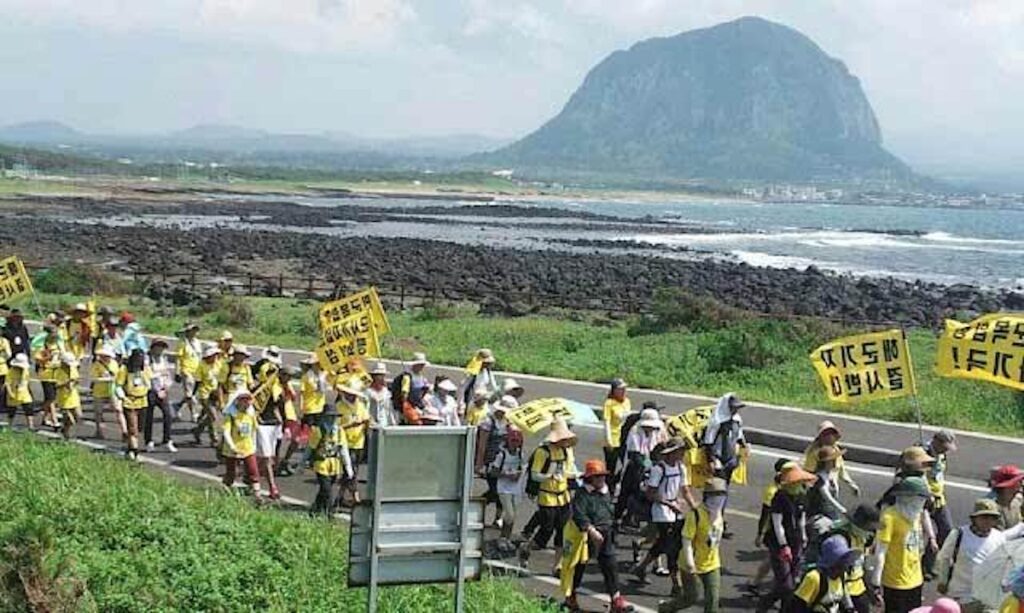This year the Republic of Korea Navy (ROKN) inaugurated a naval task force fleet command at the Jeju Naval Base.
With growing emphasis on intelligence gathering and missile defense capabilities, the strategically vital island of Jeju is a prime location for the ROKN’s task force command.
Enhancing naval movements in the wider seas to protect shipping lanes while simultaneously gathering intelligence and information from potential adversaries, the maritime task force fleet puts Seoul at the forefront of regional force projection capabilities.
Nevertheless, Jeju’s growing military presence not only has displeased rivals and adversaries but also has sparked domestic protest.
Southwest of the mainland Korean peninsula, the island lies along critical shipping and fishing lanes. Jeju is situated at the intersection of three seas: the East China Sea, the Yellow Sea (West Sea to Koreans), and the Sea of Japan (East Sea to Koreans).

Seoul relies on maritime shipping lanes for energy imports and trade from the southern shipping lanes. The naval task force fleet command can help coordinate the ROKN to secure those lanes.
Furthermore, Jeju is close to major Chinese economic hubs Shanghai, Dalian, Hangzhou and Qingdao, giving South Korea the opportunity to expand maritime surveillance of China’s PLA Navy (PLAN) and of North Korean activities.
The Jeju naval base task force command reportedly will consist of ten Aegis destroyers of the class Jeongjo the Great and four logistics ships. Plans will include several other Aegis destroyers as the command expands.
Domestic and foreign criticism
Building and implementing a naval base on Jeju didn’t come without domestic controversy, as locals and various South Korean human rights organizations see the island’s history as peaceful and free from militarism.
Before the Korean War, Jeju was the site of a major left-wing workers’ uprising that spiraled out of control and was ultimately violently suppressed by the Syngman Rhee administration with US military backing, leading to tens of thousands of deaths.
The pushback against the creation of a base on Jeju Island was so significant that construction, which started in 2007, wasn’t finalized until 2016. Locals and activists fear that a growing naval presence will make the island susceptible to missile strikes in the event of armed provocations from North Korea or China.
In Beijing’s view, the expanding ROKN’s task force command in Jeju could hinder PLAN ambitions in the Indo-Pacific, given the naval base’s strategic location, which poses several key obstacles for China.
South Korea’s naval fleet in Jeju could monitor the movements of China’s PLAN Northern Fleet, whose area of responsibility includes expanding into the Yellow Sea and defending Beijing against potential attacks.
In the vicinity of major US military bases near Okinawa, a ROKN naval task force command in Jeju can hinder China’s ambitions toward Taiwan. Beijing will need to keep Seoul neutral in the event of a potential war with Taipei. If the ROKN reaches a mutual understanding with the US Navy, the PLAN may have to divert resources to the northernmost part of the East China Sea, creating a nightmare of a new front.
Expecting intimidation
Beijing will not sit idly by as the Jeju naval task force fleet command is implemented, as the Chinese government will enact various measures towards Seoul to ensure the island doesn’t become a forward American military lynchpin.
A retired South Korean naval officer, Joshua NamTae Park, noted in a July 2025 War on the Rocks article that the Chinese government will set out to undermine the US-ROK alliance and simultaneously enact intimidation through the Chinese Northern Fleet or via North Korean provocations.
Chinese government-sponsored psychological operations in hybrid and informational warfare will take place in South Korea, which will focus on the activists and anti-militarism movements to continue domestic resistance activities against the Jeju naval task force command.
Beijing has taken note of Seoul’s lukewarm response to Pyongyang’s deployment of several thousand troops to Kursk and its acquisition of Russian components for submarines. With that knowledge, the Chinese government will seek to exploit the ROK’s political situation.
Lastly, the Chinese government will order the PLAN to increase patrols in the Yellow Sea and to deploy ‘grey zone’ tactics, such as maritime fishing and coast guard provocations such as Japan and the Philippines have endured. The key for the ROKN is not to fall for China’s bait, but to make its citizens and the international community see that Beijing is a growingly provocative actor, thereby opening the way for further security guarantees.
South Korea’s naval outpost going forward
According to Admiral Yang Yong-mo, who serves as chief of naval operations, a central focus of the task force command in Jeju will be to deter and prepare for contingencies against North Korean provocations at sea, as well as against other emerging threats such as the growing capabilities of the PLAN.
For the near future, Jeju Island will remain solely for the ROKN and will not have an American naval presence. In view of the anti-militarist sentiment on the island and a pragmatic foreign policy strategy, the Lee Jae Myung administration will not desire to provoke China while simultaneously strengthening South Korea’s independent military capabilities within the ROK-US alliance.
The implementation of the Jeju naval task force command will not only bolster South Korea’s military capabilities but also enable greater freedom to protect shipping lanes.
By showing the United States that Seoul can become more autonomous through Jeju Island, Washington will not have to allocate more resources, which would win the Lee administration favor with President Donald Trump while simultaneously enhancing South Korea’s security apparatus.

